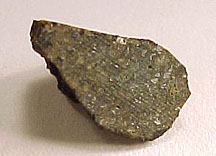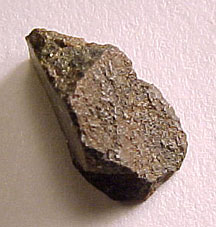Eustis
H4
Found 1918
28° 50′ N., 81° 41′ W. A highly weathered stone weighing 502 g was found by Mr. Alger of Eustis, Florida while plowing new land on which pine trees had recently been cut. The meteoriteWork in progress. A solid natural object reaching a planet’s surface from interplanetary space. Solid portion of a meteoroid that survives its fall to Earth, or some other body. Meteorites are classified as stony meteorites, iron meteorites, and stony-iron meteorites. These groups are further divided according to their mineralogy and Click on Term to Read More was located a few inches under the surface of the sandy soil. From the fragmental shape of the stone and its still distinct primary and secondary fusion crustMelted exterior of a meteorite that forms when it passes through Earth’s atmosphere. Friction with the air will raise a meteorite’s surface temperature upwards of 4800 K (8180 °F) and will melt (ablate) the surface minerals and flow backwards over the surface as shown in the Lafayette meteorite photograph below. Click on Term to Read More, it is inferred that Eustis is a fragment from a larger meteorite mass. It was noted by Mr. Alger that about 25 years before his discovery, a family located 2 miles from Eustis witnessed a meteorHow long Sonic booms Of the several 10s of tons of cosmic material entering Earth's atmosphere each day, only about one ton reaches the surface. An object's chance of survival depends on its initial mass, speed and angle of entry, and friability (tendency to break up). Micrometeoroids radiate heat so Click on Term to Read More traveling in the direction of Eustis and even made a search for the possible meteorite. While not verifiable, it is reasonable to assume that the Eustis meteorite fell at this time.
The main massLargest fragment of a meteorite, typically at the time of recovery. Meteorites are commonly cut, sliced or sometimes broken thus reducing the size of the main mass and the resulting largest specimen is called the "largest known mass". Click on Term to Read More comprising 480 g had been in the Smithsonian Collection, USNM 581, until a recent trade initiated by M. Horejsi that resulted in the release of a 10.5 g slice. The photo above shows a 0.4 g cut fragment removed from the dark lithology of the trade specimen and shows chondrulesRoughly spherical aggregate of coarse crystals formed from the rapid cooling and solidification of a melt at ~1400 ° C. Large numbers of chondrules are found in all chondrites except for the CI group of carbonaceous chondrites. Chondrules are typically 0.5-2 mm in diameter and are usually composed of olivine Click on Term to Read More and abundant flakes of free metalElement that readily forms cations and has metallic bonds; sometimes said to be similar to a cation in a cloud of electrons. The metals are one of the three groups of elements as distinguished by their ionization and bonding properties, along with the metalloids and nonmetals. A diagonal line drawn Click on Term to Read More (these were described in 1918 by Merrill as ‘abundantly besprinkled with small flecks of metal’). The photo below shows the fusion-crusted side of this fragment.
Due in part to the intense temperature and moisture conditions in the state of Florida, only four meteorites have been found there to date, in addition to two recovered falls. Besides Eustis, approximately 1 kg of L4 fragments were brought up in a net offshore of Lake Okechobee, a 41.8 kg H5 stone was found in Bonita Springs, and a 10.9 kg H5 stone was found near Grayton Beach. In 2004, November 8 at 6:15 P.M., Orlando resident Donna Shuford heard a meteorite bounce off her car and hit the side of her house. Fragments composing an ~180 g eucriteMost common type of achondrite meteorite and a member of the HED group. Eucrites are basalts composed primarily of pigeonite and anorthite (An60-98). Eucrites have been placed into three subgroups based on mineralogical and chemical differences. • Non-cumulate eucrites represent the upper crust that solidified on a magma ocean after Click on Term to Read More were recovered. In 2016, January 24 at 10:27 A.M., numerous eyewitnesses observed a bright fireballA fireball is another term for a very bright meteor, generally brighter than magnitude -4, which is about the same magnitude of the planet Venus as seen in the morning or evening sky. A bolide is a special type of fireball which explodes in a bright terminal flash at its end, often with visible fragmentation. Click on Term to Read More over northern Florida near the Osceola National Forest. Utilizing radar images from several stations, a group of hunters successfully plotted the fallMeteorite seen to fall. Such meteorites are usually collected soon after falling and are not affected by terrestrial weathering (Weathering = 0). Beginning in 2014 (date needs confirmation), the NomComm adopted the use of the terms "probable fall" and "confirmed fall" to provide better insight into the meteorite's history. If Click on Term to Read More site and recovered 8 stones over many weeks having a combined weight of 1,099.6 g. The L6 chondriteChondrites are the most common meteorites accounting for ~84% of falls. Chondrites are comprised mostly of Fe- and Mg-bearing silicate minerals (found in both chondrules and fine grained matrix), reduced Fe/Ni metal (found in various states like large blebs, small grains and/or even chondrule rims), and various refractory inclusions (such Click on Term to Read More fell within a forested wetlands region delimiting a strewn field of approximately 5 miles × 1 mile.
The Eustis photos on this page are shown courtesy of Martin Horejsi.








